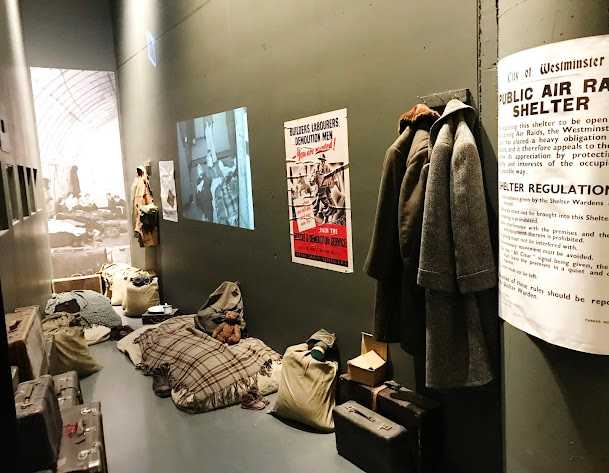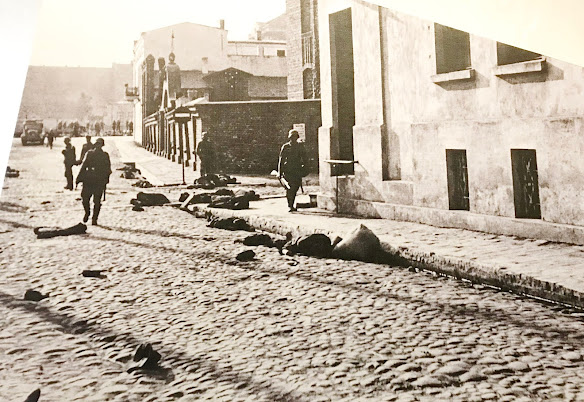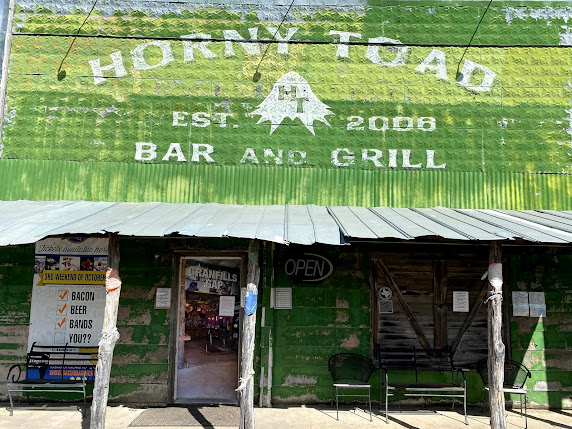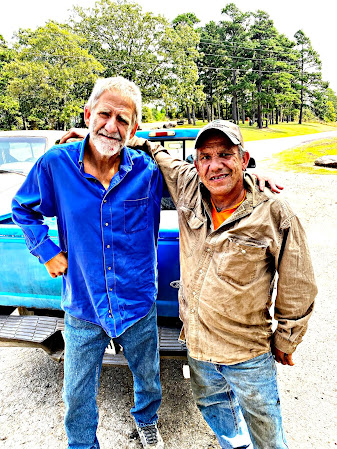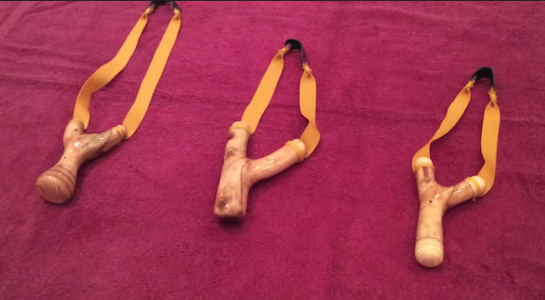Sculpting the Woods
Why don't you just hire a dozer to clear the Yaupon thickets from your property?
 |
| Garden Glade |
It's a question I am often asked and even ask myself. But, if I gave a dozer driver instructions to take only Yaupon and leave other native species of shrubs and trees that I wish to keep, would he be able to do that? I don't think so. It would require that he leave the seat of his dozer before dozing every shrub to make sure it is not a Possum Haw, Swamp Privit, American Beautyberry, Mulberry, Rusty Blackhaw, Eastern Red Cedar, Texas Sophora, Holly, Basswood, Mexican plum or Black Cherry that I wish to keep. So, why do I wish to keep these species? Well, it's because I view my property as a private park -- not a ranch or farm -- and I really enjoy trees, grasses and shrubs. As a matter of fact, the sign posted on a tree inside our gate identifies this property as "Pat's National Park" -- named after my wife Pat.
When we first bought this woody property over 50 years ago, one of my goals was to keep it as "natural" as was reasonable. We had 20 acres of heavily wooded thickets that we could hardly walk through without considerable effort and bloodshed. But, it was loaded with wildlife and potential. The folks that sold us this property had dozed the vegetation on the property line in order to build a fence. So when we came from our city dwelling to visit our property, we could drive our cars in along this cleared fence-line without disturbing the woodlands. But, over the years, "natural" changed to "semi-natural" as we opened a driveway through the woods into the center of the property. After our children left home, we sold our home in College Station and lived full-time in motorhomes. During the winter, we often parked our motorhome on this property for various periods of time while we took our yearly medical checkups and dental appointments. After about a week or so, in these woods, it was necessary to drive into College Station to dump sewage and fill our water tank. But, running the electrical generator every time we needed electricity became very onerous, so we had the local electric service install a line into the property. So much for a completely natural system.
 |
| Yaupon Thicket |
 |
| Driveway |
Once upon a time, before there were fences in this country, wildfires likely killed much of the Yaupon -- so that describing this area of Texas as a Post Oak Savannah was appropriate. A savanna consists of a mixture of woods and grasslands. At some point, the local authorities issued burn bans during very dry periods and intentional burning of understory shrubs, vines and grass became illegal due to the hazard of fires spreading onto neighbor's properties. Without wildfires, the Yaupon became so thick that it was difficult see the beautiful big oaks, elms, ashes, birch, bamboo, and basswood trees that all together shaded out many of the native grasses. But, of course, Youpon is not the enemy -- it just needed to be managed to open up the savanna part. Consequently, several years ago I began to clear some areas. In 2010, a severe drought killed many of the trees. One of the first to die was a huge Black Jack oak. It left a big hole in the canopy so I decided that it provided a good place to start a garden. I cranked up my chain saw and cleared that dead tree and 1/10th of an acre of under-story and roots for a garden. Removing the above-ground parts was easier than removing all the roots. Pat helped with this big job. So now we could stop clearing the trees, vines, shrubs etc. Right?
No way! The vegetation that died from the drought did not all die at once. My initial thought was that I would simply let the dead trees decay and fall on their own -- thus, creating habitat for various plants and animals. But, it soon became obvious that this process was creating an abundance of dead wood that would provide the fuel for potential forest fires. Because our home was now located in the center of these woods, wildfires could be a great hazard to our cozy abode. But, they could also spread into our neighbor's woods, so I have also cleared fire breaks on both the north and south sides of the property to minimize the risk to our neighbors or from our neighbors. But, it was never my intention to clear the entire 20 acres -- an almost impossible job for one old man with a chain-saw. However, due to circumstances that cause trees to die and my desire to re-create a savanna, I have cleared much, much more than I ever intended. Oh, well.
About 50 yards northwest of our home, another huge tree fell which pulled down several others -- all linked together with grape vines and briers. It was a huge mess and constituted a major fire hazard. I climbed into the center of the pile with a chain saw and started clearing enough space for a small fire. As I expanded this space by cutting the logs, vines, and branches around me, I added everything I cut to the center fire. After a couple of weeks of cutting every day, I realized that it provided an open space in the woods, large enough for a small orchard. So, I fenced it in to keep out the ever-present deer and planted three peach trees, two apple trees and a persimmon.
Surprise! When I clear a mot of native yaupon, I am often surprised by the beauty of the large trees and blue skies that I was previously unable to see through the thicket. I can even sometimes see sunrises and sunsets -- although still through the trees. With a solid yaupon thicket, we could never see these sights. Also, summer breezes now grace our porches with relief from summer heat. But the downside is that cold winter winds now penetrate to places they could not before.
 | |
| Sunrise Through the Trees |
As I finally realized, this property had far too many shrubs and trees. It was fundamentally a 20 acre thicket, so I decided that a savanna might be a more pleasant place for frolicking than a thicket.
As I cleared out dead trees and shrubbery in spots, I decided to provide them with names -- such as glens, glades, groves, trails, senderos, mots and a creek. Then, to distinguish between, them, I identified a shady glen, a blackhaw glade, a pecan grove, a dogwood grove, a bamboo grove, a cedar grove, a farkleberry grove, a tunnel trail, a cross trail, a main sendero, a creek trail, and miles of other unnamed trails. Often I left patches (mots) of yaupon for wildlife cover and diversity.
 |
| Shady Glen |
 | |
| Wickson Creek |
 | ||
| Dogwood Grove |
 | |
| Sendero Glade |
 | |
| Bamboo Grove |
Then, last year a wind storm toppled whole trees and limbs over much of the acreage. Sawing and burning these has been a time-consuming activity this year. Several trails, groves and glades were blocked by piles of this stuff. However, all trails, groves, glades, and senderos were now open. At least until 4-inchs of heavy, wet snow fell on January12th or 2021 which broke many limbs that blocked the driveway and many trails. Oh, no! Here I go again.
 |
| Snow Storm Damage |
As I tried to simulate a natural savanna, I was also interfering with nature. What I was really doing was sculpting my woodlands to make it fit my mental model of a savanna. I was playing God with these woodlands -- and it was fun. You know, like politicians play God with our civilization.
This year, the Covid epidemic forced us to remain at home for most of the time, so I am sculpting more woodlands than normal this year (2020-2021). Cutting and hauling wood and limbs is good exercise. Sore muscles in my arms and back at the end of a work-day are testament to the number of logs and limbs carried.
And, it's only a slight exaggeration to rename these sculpted woods "Pat's National Park." Right?
 |
| Pat's National Park |
Table of Contents: https://www.blogger.com/blog/post/edit/6813612681836200616/3382423676443906063?hl=en














